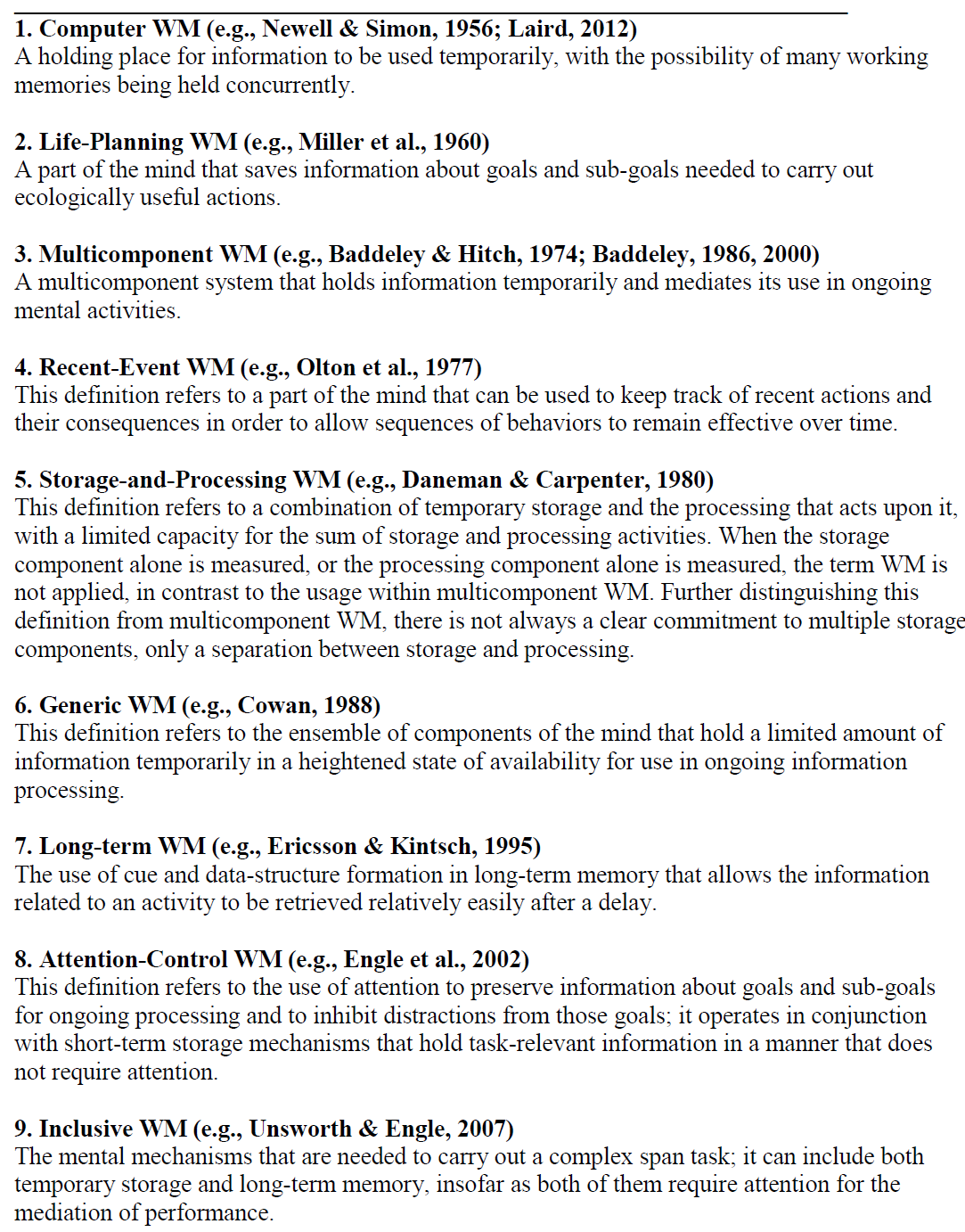Type “working memory” into Google Scholar and you get nearly 2,000,000 results. Topping the list is the paper “working memory” by Alan Baddeley and Graham Hitch, which has been cited more than 12,000 times since its publication in 1974. The Web of Science search engine is slightly more modest, with around 54,000 scientific publications being returned for the same search string. The latest 5 of those papers were published in January of next year, thus being at the cutting edge not only of science but also of time itself.
And on the Psychonomic Society’s featured content blog, there are 43 entries for working memory. Clearly, working memory (or WM for short) is a core attribute of human cognition.
But what is WM?
According to Wikipedia, “working memory, a core executive function, is a cognitive system with a limited capacity that is responsible for the transient holding, processing, and manipulation of information.” Although this definition is a pretty good approximation, it turns out that the definition of working memory is a bit more nuanced and not always entirely straightforward.
In a recent article in the Psychonomic Bulletin & Review, Nelson Cowan took up the issue of what exactly is working memory. Cowan motivated his work by noting that “a major source of confusion is that researchers use different definitions of the malleable and useful concept of WM. We do not seem to converge on a common definition of the term.”
To resolve this confusion, Cowan then proceeds to survey 9 different definitions of the term WM that have been used in various contexts and by different teams of researchers. I provide a brief overview of Cowan’s article in this post, and for the remainder of the week three other researchers in working memory—Klaus Oberauer, Candice Morey, and Judith Schweppe—will take turns commenting on Cowan’s work, before the author responds in a final post on Friday. (Update 2 December 2016: Oberauer’s post is here; Morey’s here; Schweppe’s here; and Cowan’s reply is here.)
The figure below provides a thumbnail summary of Cowan’s taxonomy of definitions of working memory:

Those definitions differ widely in their popularity and historical context. For example, the notion of a computer WM is mainly of historical interest and refers not to a psychological concept but to the design of computer programs in the 1950s that could solve proofs in symbolic logic.
Perhaps the most commonly used definitions of WM comprise the “multicomponent” view offered by Baddeley and Hitch in their seminal paper, the “generic” view that considers WM to be mental representations that are currently in a heightened state of accessibility, and the “storage-and-processing” view which thinks of WM not just as a passive memory but an additional active processing component. The “attentional” view of WM goes even further by emphasizing cognitive processing—such as inhibition of distracting information—in preference to storage of information.
In other words, WM can be anything from passive storage to active processing or anything in between.
A similar ambiguity surrounds the measurement of WM: what is the capacity of a person’s WM? Is it 3 items, 4 chunks, or 8 letters? This is a non-trivial question because, as we have noted on this blog earlier, the capacity of WM explains fully half the variance in people’s IQ.
Some researchers suggest that working memory capacity is best measured using the “complex-span” task in which processing (e.g., deciding on the validity of an arithmetic equation such as 8+3=13) alternates with encoding of the memoranda, whereas “short-term” memory is best measured by “simple-span” tasks. In a simple-span task, participants are asked to memorize a brief list of verbal items and recall it immediately in the order of presentation. This task is presumed to tap one of the components of the working memory model of Baddeley and Hitch, known as the phonological loop, adding further nuance to what exactly the various tests are measuring and what exactly we should understand WM to be.
How are we to respond to this ambiguity and multitude of measures and definitions? If we do not agree on what WM is how can we examine it in 54,000 publications? How can we even talk about WM?
The commenters during the remainder of the week will take up this conundrum, with Schweppe likening WM nomenclature to a game of “Chinese Whispers”; Morey arguing that the validity of the WM construct does not depend on it upholding the assumptions of one particular theory; and Oberauer pointing out that despite the multiplicity of definitions and models, researchers do share a strong consensus about what phenomena are and are not about WM.
Article focused on in this post:
Cowan, N. (2016). The Many Faces of Working Memory and Short-term Storage. Psychonomic Bulletin & Review. DOI: 10.3758/s13423-016-1191-6

2 Comments